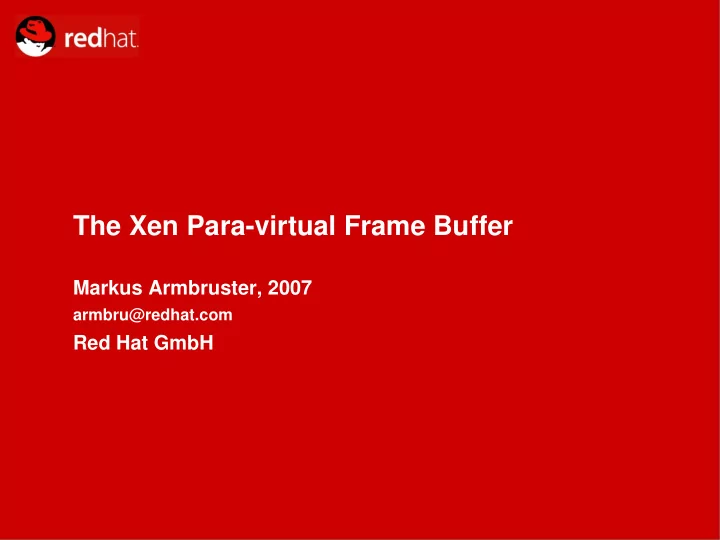

The Xen Para-virtual Frame Buffer Markus Armbruster, 2007 armbru@redhat.com Red Hat GmbH
What, Why and Who What? ● A para-virtual driver for a virtual frame buffer device Why? Want a graphical console Just like a real machine, just like FV Whodunnit? ● Anthony Liguori Design and initial implementation ● Markus Armbruster & others Flesh out, fix, extend
Architecture Similar to common split driver architecture: ● Frontend in domU: xenfb and xenkbd kernel modules ● Backend in dom0: user space VNC server or built-in viewer ● Communicate through shared memory page and event channel shared frame buffer ● Forward compatible protocol
Status Features: ● VNC or built-in viewer (SDL) ● Smart frame buffer update tracking ● Partial support for funny keyboards ● Support for absolute pointer ● Support for save/restore
Status Non-features: ● Dynamic resolution ● Multiple frame buffers per guest Misfeatures: ● Should share more code with FV ● and possibly other user space backends ● PTE update race
Availability Merged in Xen 3.0.4 Shipped in major distributions
Funny Keyboards: What's the problem? The situation: ● User types on a real keyboard ● System maps his keystrokes to key events ● Virtualization software conjures up a virtual keyboard ● Virtual system maps virtual keystrokes to key events The problematic step: Mapping real key events to virtual keystrokes
Funny Keyboards: Preserve key events Idea: make virtual key events = real key events Need to know virtual mapping Unless virtual keyboard/keymap = real keyboard/keymap: ● virtual keystrokes ≠ real keystrokes ● virtual keystroke may not exist ● may not be able to produce all virtual keys
Funny Keyboards: Keys, not key events Idea: map real key to virtual key Virtual keys: Linux input layer key codes Identify real keys? X key code depends on hardware built-in viewer assumes Xorg & PC VNC's RFB protocol doesn't provide it VNC server maps from X keysym this needs to invert the real keymap choose one in domU config if multiple keys map to same keysym: guess
Lessons Learned: Protocol Forward-compatible protocol sound so far, but dumb oversights: ● Shared data-structures varied 32 vs. 64 bit ● Shared pages not zeroed Solved using excessive cleverness
Lessons Learned: Implementation Playing VM games is subtle business Split driver initialization and shutdown pitfalls VNC's RFB protocol doesn't give us keys
The Xen Para-virtual Frame Buffer Markus Armbruster, 2007 armbru@redhat.com Red Hat GmbH
Recommend
More recommend